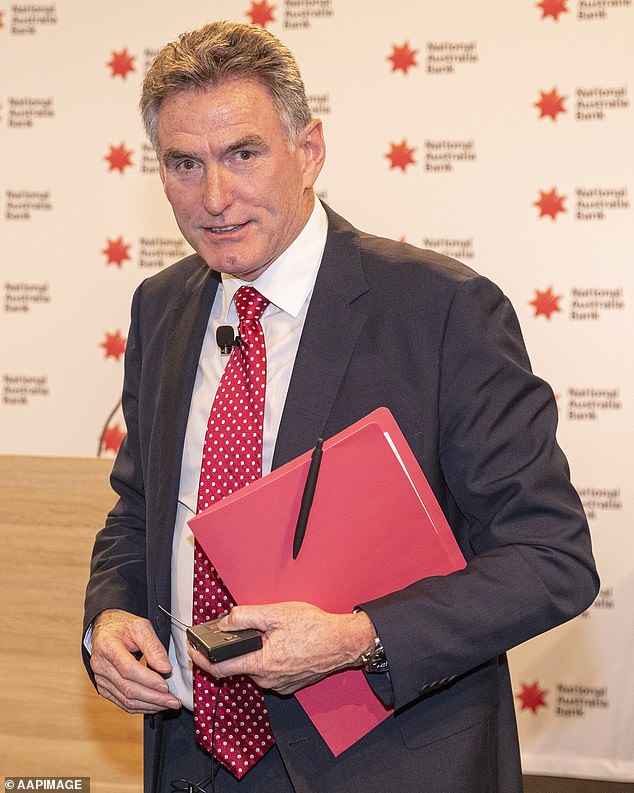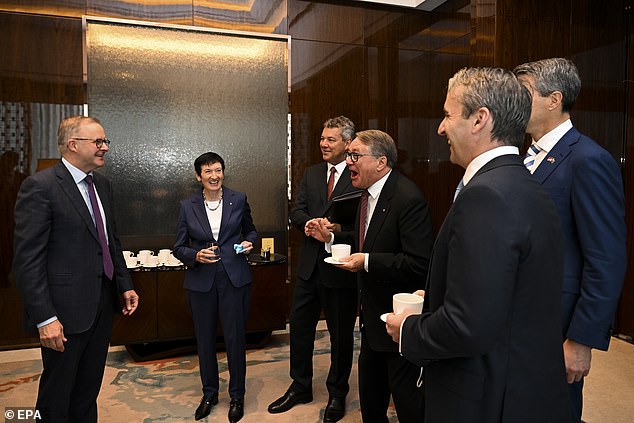The simple reason why these Big Four bank CEOs are getting filthy rich – even though Aussies savings at 2008 low
The top executives of the Big Four banks are earning eye-watering millions of dollars even as Australian savings rates are at their lowest level in 15 years.
With less savings in their accounts, the banks have to borrow from other banks to lend to home borrowers and take advantage of charging interest.
That increases the cost of doing business because banks have to pay other banks when they borrow money from them.
But despite that, the banks have posted record profits, leading to top executives receiving large pay raises and bonuses on top of their already very generous multi-million dollar salaries.
Commonwealth Bank CEO Matt Comyn received $10.426 million last fiscal year, an increase of $3.5 million or 50 percent from $7 million in 2021-2022.
His bonuses boosted his $2.5 million base salary, while CBA’s cash profit, which covered core businesses, rose six percent to a record year to June. $10.164 billion for Australia’s largest home lender.
Mr. Comyn was not the only well-paid CEO; his colleagues at NAB, Westpac and ANZ took home between $4 million and $6 million.
But they could get even more in 2023 if healthy full-year earnings results to be announced in the coming months will boost their bonuses as rising immigration gives banks more potential home borrowers.
Commonwealth Bank CEO Matt Comyn received $10.426 million last fiscal year, an increase of $3.5 million or 50 percent from $7 million in 2021-2022
Bank bosses are well paid, even as Australian savings rates fell again in the June quarter to just 3.2 per cent, the lowest level since June 2008 – a period when Reserve Bank rates also reached their highest level in a decade.
This was down from the 3.6 percent in the March quarter of 2023.
National accounts data from the Australian Bureau of Statistics shows that the household saving rate is falling for the seventh consecutive quarter.
As recently as September 2021, household savings – as a percentage of after-tax income – stood at 19.3 per cent when Sydney and Melbourne were in lockdown.
This was only slightly below the June 2020 level of 19.8 per cent, the highest level since June 1974, during the early months of the Covid pandemic when the border was closed to foreigners and Australians banned from holidaying abroad to travel.
But 12 interest rate hikes since May 2022 have caused monthly mortgage payments on a variable loan to rise conservatively by 63 percent, leading to a fall in savings rates.
Australia still had a savings rate of 11.3 percent in March 2022, when the Reserve Bank’s cash interest rate was still at a record low of 0.1 percent.
The most aggressive pace of monetary policy tightening since 1989 has caused cash interest rates to rise to an 11-year high of 4.1 percent, prompting borrowers to use their savings to pay off high mortgage payments. to pay.
Savings rates have fallen to the lowest level seen in mid-2008, during the earlier phase of the global financial crisis, when cash rates reached a 12-year high of 7.25 percent after six years of rate hikes.
But the banks have also benefited from high immigration during a cost-of-living crisis, drawing more potential home loan customers.
The banks have done well, even as Australia slipped into a per capita recession in the June quarter, for the first time since the Covid 2020 lockdowns, with output slipping for every Australian.
David Llewellyn-Smith, the chief strategist of MB Super and Nucleus Wealthsaid the banks benefited from population growth.
“Usually the winners of that immigration model – even in a recession by capital – are the banks, retailers and developers,” he told Daily Mail Australia.
“If you add those three together you get what is known as the growth lobby and they are pushing for the model to continue because it is good for them but not good for the average Australian.”

NAB CEO Ross McEwan to receive $3.89 million in 2022 as bonuses boost his $2.5 million base salary

Westpac CEO Peter King (right next to former chairman Lindsay Maxsted) received $3.9 million last year while Westpac made a statutory net profit of $5.7 billion
The Big Four banks are all members of the Business Council of Australia, which has pushed for high immigration and lobbied the federal government, with outgoing President Jennifer Westacott making public appearances with Prime Minister Anthony Albanese.
The Commonwealth Bank’s annual report for 2023 praised population growth for helping it financially.
The Australian economy has proved resilient, with the tailwinds of a recovery in population growth, relatively high commodity prices and low unemployment.
The Commonwealth Bank is the only one of the Big Four to release full-year earnings in 2023, but preliminary results indicate they are all profitable.
National Australia Bank, the largest corporate lender, reported unaudited statutory profit of $1.75 billion in the three months to June 2023.
NAB CEO Ross McEwan received $3.89 million in 2022 as bonuses boosted his $2.5 million base salary, with the bank making a full-year statutory profit of $6.89 billion.

ANZ CEO Shayne Elliott received $6 million last year as bonuses boosted his $2.5 million base salary
Westpac’s third quarter results showed unaudited net income of $1.8 billion for the three months through June.
CEO Peter King received $3.9 million last year, while Westpac made a statutory net profit of $5.7 billion.
ANZ made a net profit of $3.82 billion in the six months to March.
The bank’s CEO, Shayne Elliott, was paid $6 million last year as bonuses boosted his $2.5 million base salary and ANZ made a full-year cash profit of $6.5 billion.
Mr Llewellyn-Smith said the Treasury, which sets economic and immigration policy, wanted population growth so it could collect more tax revenue.
“The federal government has a vested interest in the model because a larger population contributes to budget repair,” he said.
“In individual terms or per capita, the standard of living is falling, the budget is being restored.
“They can claim good economic management, even though individual Australians are all going downhill.”

The Big Four banks are all members of the Business Council of Australia, which has pushed for high immigration and lobbied the federal government, with outgoing President Jennifer Westacott (second from left) making a public appearance with Prime Minister Anthony Albanese (far left) ) and Commonwealth Bank CEO Matt Comyn (second right)
Australia’s net overseas migration level for the year to June was a record 353,670, the highest ever for a fiscal year, based on the permanent and sustained arrival of skilled migrants and international students.
The population growth rate of 2 percent is among the highest in the developed world, with only Canada, Singapore and Israel experiencing higher growth rates.
Despite the per capita recession, treasurer Jim Chalmers put his own spin on falling savings rates.
“The Australian economy remains stable and robust despite the continued pressure,” he said.
“Australians continue to scale back discretionary spending to make room for essentials and also to cover mortgage payments.”

